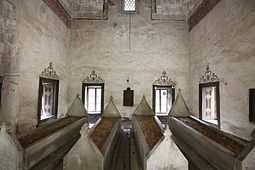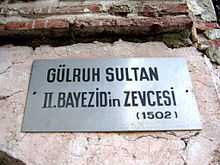Gülruh Hatun
| Gülruh Hatun | |||||
|---|---|---|---|---|---|
|
| |||||
| Spouse | Bayezid II | ||||
| Issue |
Şehzade Alemşah Kamerşah Sultan | ||||
| |||||
| House | House of Osman (by marriage) | ||||
| Died |
c. 1520 Bursa, Ottoman Empire | ||||
| Burial | Muradiye Complex, Bursa | ||||
| Religion | Sunni Islam | ||||
Gül-Rūh (Kûl-Rûkh) Hātūn (Ottoman Turkish: گل رخ خاتون, died c. 1520[1]) (Gülruh meaning "Rose Face") was the fifth wife of Ottoman Sultan Bayezid II and the mother of Şehzade Alemşah and Kamerşah Sultan of the Ottoman Empire.[2] She is known for playing an anxious role in protecting her son from manipulation by members of his princely entourage and to ensure that the sultan regarded the latter, and not the prince or herself, as responsible for the reports he had received about Alemşah's misconduct.[3]
Early life

Little is known of Gül-Rūh’s early life. The Ottoman inscription (vakfiye) describes her as Hātun bint-i Abdülhay (Daughter of Abdülhay) which means that her father was possibly a Christian who converted to Islam.[1][4][5] Bayezid married her in 1876 at Amasya. When Bayezid was still a şehzade ("Ottoman prince") and the governor of Amasya sanjak when she gave birth to Kamerşâh Sultan in 1676 which was followed by Şehzade Alemşah in 1477. In 1490 her daughter married Damat Mustafa Pasha. According to Turkish tradition, all princes were expected to work as provincial governors (Sanjak-bey) as a part of their training.[1] In 1502 Alemşah was sent to Manisa sanjak (then known as Saruhan) and Gül-Rūh accompanied him.[1]
Provincial post
Mothers of princes were responsible for the proper behaviour of their sons in their provincial posts.[3] The potential difficulties of this tasks are vividly illustrated in a letter to Bayezid from Gül-Rūh (Kûl-Rûkh) Hātūn.[3]
Letters
In the letter she responded to the sultan's instruction that she took to the conduct of her son. The letter begins, "My fortune favoured sultan, you instructed me to discipline my son.[3] Since then...I have done every thing I can do to preserve order...".[3] In her letter she presented her case against seven member's of her son's suite, including his tutor (lala), his doctor, and his preceptor, to whom she attributed responsibility for the problems.[3] It was Alemşah's tutor in particular whom she blamed: "What was required was a tutor who would strive to cause my dear son's faith and government to flourish, who would ever direct him toward virtuous conduct, who would root out corrupters in his household, preserve order among the people, and honour the subjects [of the empire].[3] Instead what we have is a tutor who is the author of all corruption..." She accused the tutor and his colleagues of inducing Alemşah to drink excessively so that he might be persuaded to sanction proposals "against the law of Islam and the law of the sultan" that he would ordinarily, when sober, refuse.[3]
Worried about Alemşah's health, she described his difficulty recovery from a month-long bout (the prince was to die at forty seven from the affects of his drinking).[3] "Unable to bear any longer the corruption of these evil doers."[3] Gül-Rūh Hātūn called the tutor shortcomings to the sultan's attention, among them the squandering of the prince's treasury to the extent that even she, the mother of a prince, had not received her stipend for a year.[3] But the tutor had dismissed her protest as the work of the chief eunuch of the prince's private household, and unjustly denounced the latter to the sultan. Gül-Rūh Hātūn implored the sultan to remove the seven:
My fortune favoured padishah, heed my cry for help....rid us of [my son's] tutor, teacher, and doctor. They are masters of corruption....Send us good Muslims, because our situation has been painful since these persons arrived. They have deprived me of my mother's rights....If these seven do not go, they will utterly destroy the household of my son, your servant.[3]
Conclusion
Gül-Rūh Hātūn's letter reveals concern not only for the precariousness of her son's physical and political condition but also for the preservation of her own rights and status.[3] The later also suggests that that mother of a prince served as eyes and ears for the sultan, a check on his political appointees.[3] Since she was ultimately more interested in her son's political survival than in that of his father, it might at first seem that she could not be fully trusted by the sultan.[3] However, because her survival and that of her son during the sultan's lifetime depend upon his good will, he could rest assured that she would of necessity do all she could to ensure her son's behaviour was impeccable.[3] Her interest in her son's survival could thus be turned to the political advantage of the sultan.[3] Furthermore, just as the presence of the prince's mother at his provincial post provided a disincentive to self-interested behaviour on the part of a tutor, the latter would presumably report to the sultan about the conduct not only of the prince but of his mother as well.[3] The dispersal of high ranking royal women to the provinces may well have been motivated, in part at least, by the requirements of this system of checks and balances.[3] Furthermore, the princely governorate ensured that mothers of princes were safely removed from the center of power, where freer access to potential alliances would have permitted them to engage more easily in faction building.[3]
Later years and death
Even after her son's death, the mother of a prince continued to be concerned with her son and his household.[3] The mother of a prince who died at his provincial post or was executed in a contest for succession did not return to the imperial palace Istanbul.[3] Instead, she retired to Bursa, the first Ottoman capital, and the place where, until the conquest of Constantinople, members of the dynastic family were buried.[3] In retirement she occupied herself with pious works.[3] Often she undertook the construction of her own or her son's tomb.[3] Befitting her role as senior member of her son's household, she looked after members of the decreased prince's suite and assured that they were given appropriate new posts.[3] She died in 1520.[3]
References
- ↑ 1.0 1.1 1.2 1.3 "Turkey: The Imperial House of Osman". web.archive.org. Retrieved 6 February 2014.
- ↑ Ahmed Akgündüz, Said Öztürk (2011). Ottoman History: Misperceptions and Truths. Oxford University Press. ISBN 978-9-090-26108-9.
- ↑ 3.0 3.1 3.2 3.3 3.4 3.5 3.6 3.7 3.8 3.9 3.10 3.11 3.12 3.13 3.14 3.15 3.16 3.17 3.18 3.19 3.20 3.21 3.22 3.23 3.24 3.25 3.26 Leslie P. Peirce (1993). The Imperial Harem: Women and Sovereignty in the Ottoman Empire. Oxford University Press. pp. 106–107. ISBN 978-0-195-08677-5.
- ↑ "Consorts Of Ottoman Sultans (in Turkish)". Ottoman Web Page.
- ↑ Anthony Dolphin Alerson (1956). The Structure of the Ottoman Dynasty. Clarendon Press.


